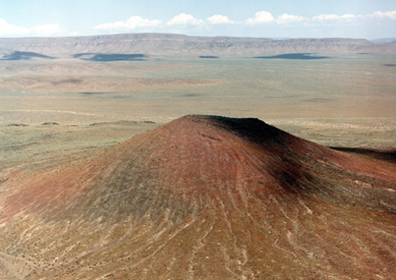
Geotimes Home | AGI Home | Information Services | Geoscience Education | Public Policy | Programs | Publications | Careers

 The nation’s
planned nuclear waste storage facility at Yucca Mountain in Nevada sits across
the border from California’s Death Valley in a relatively quiet yet recently
active volcanic field. Cinder cones dot the ancient basaltic lava flows. At the
southern tip of Yucca Mountain, the Lathrop Wells cinder cone stands as a reminder
of the most recent eruption, which struck about 80,000 years ago.
The nation’s
planned nuclear waste storage facility at Yucca Mountain in Nevada sits across
the border from California’s Death Valley in a relatively quiet yet recently
active volcanic field. Cinder cones dot the ancient basaltic lava flows. At the
southern tip of Yucca Mountain, the Lathrop Wells cinder cone stands as a reminder
of the most recent eruption, which struck about 80,000 years ago.  |
Geotimes Home | AGI Home | Information Services | Geoscience Education | Public Policy | Programs | Publications | Careers |